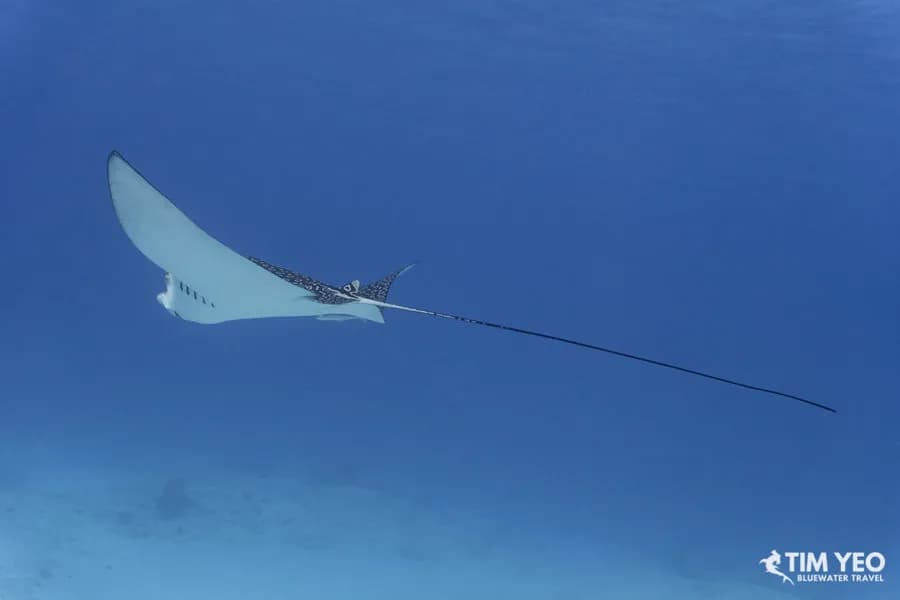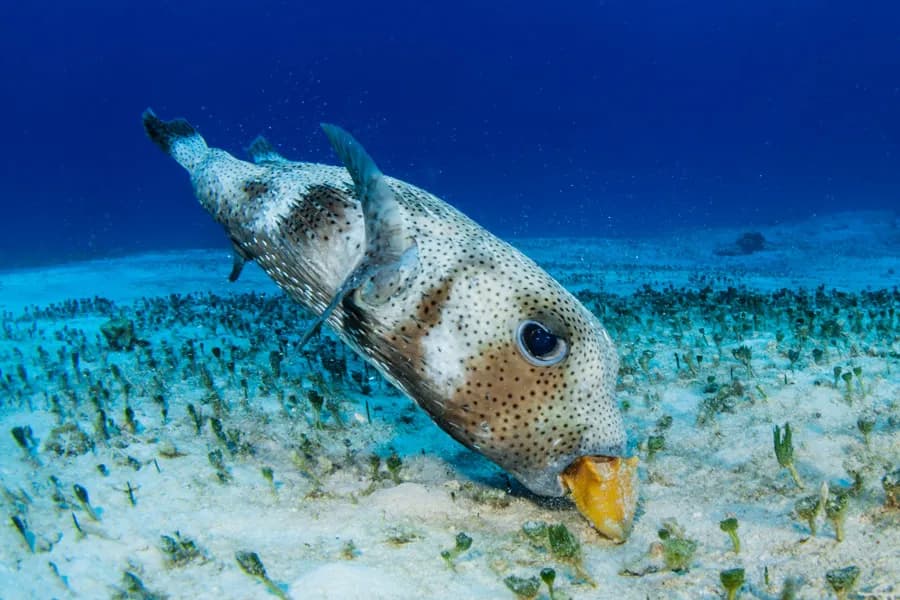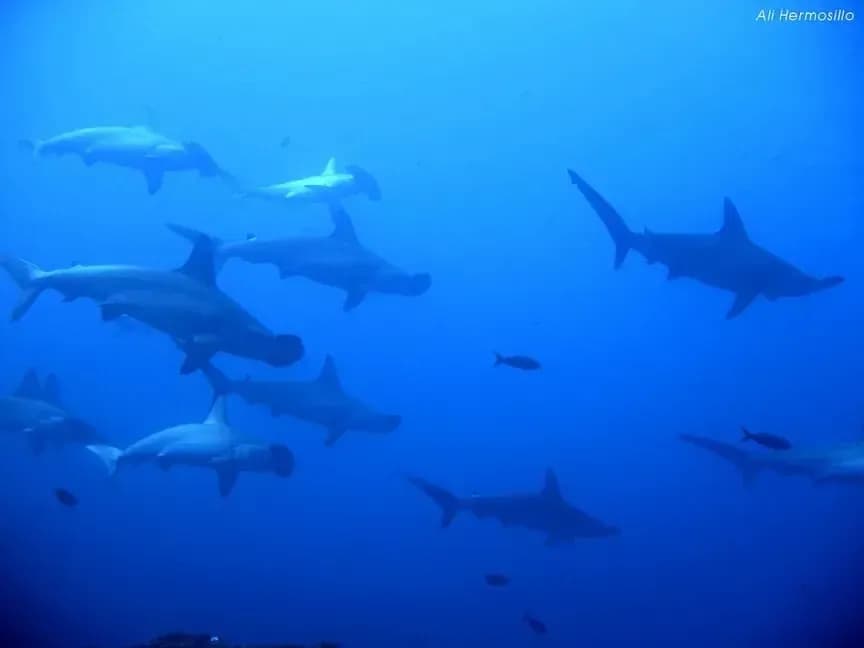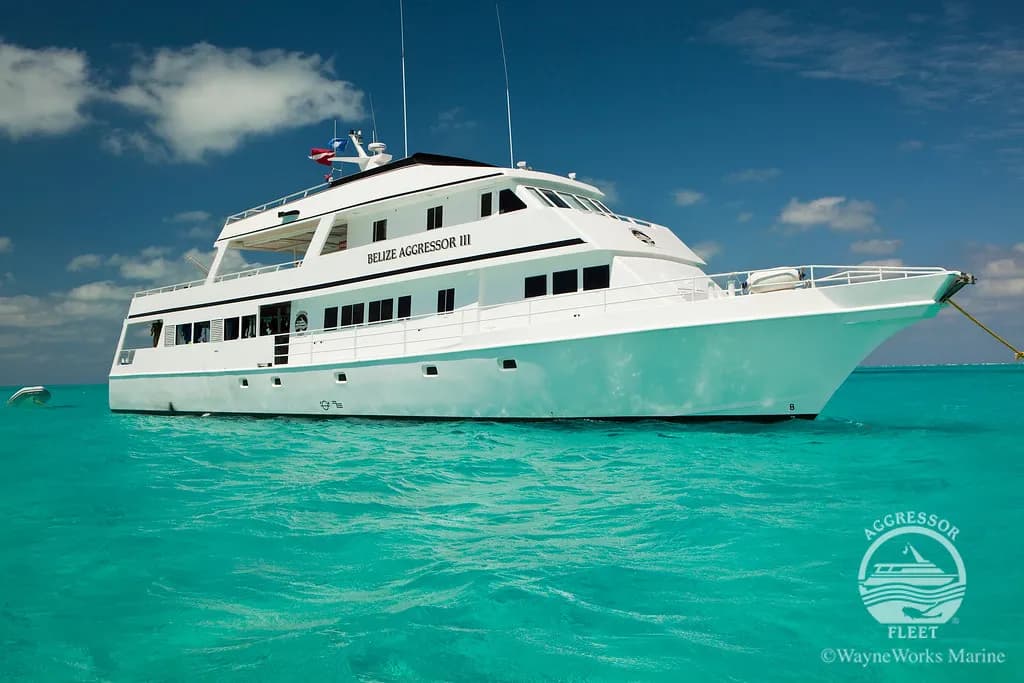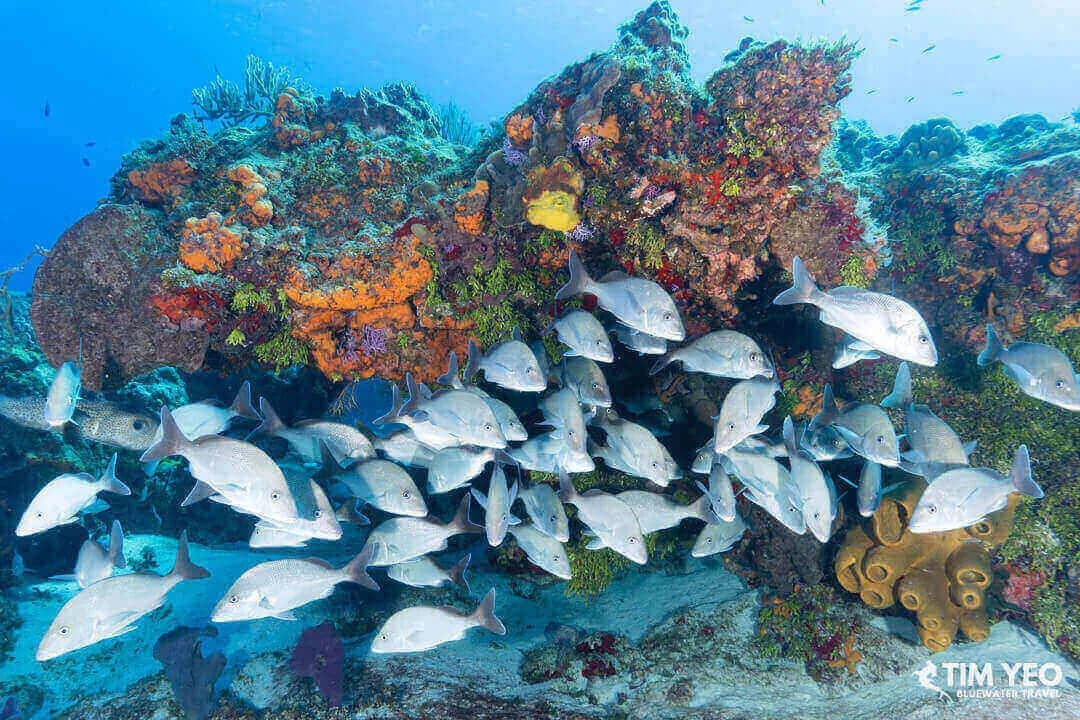Best Scuba Diving in Cozumel in 2025
Destination Highlights
Scuba Dive Level
All Levels
Visibility
80 to 100+ feet (24 to 30+ meters)
Average Water Temperature
80
Stunning Reefs & Corals
Wall Diving
Scuba Diving In Cozumel, Mexico
Cozumel Diving Highlights
Explore Cozumel diving to experience renowned coral reefs and some of the most accessible and best scuba diving in Mexico. Cozumel is a year-round scuba diving destination on Mexico's Caribbean coast, known for its easy drift dives with stellar visibility, vibrantly colored sponges, and marine life like turtles, nurse sharks, and rays. With a wide variety of dive sites suitable for all experience levels, Cozumel is an ideal vacation spot for families, friends, and solo travelers. For an all-inclusive diving experience in Cozumel, consider joining our Super All-Inclusive Cozumel Group Trip 2026, offering expert guides and vibrant marine life.
The Cozumel scuba diving scene is also known for its assortment of well-run dive-focused resorts, from budget to luxury. Boasting great nightlife and an endless list of things to do, Cozumel is a popular travel destination for scuba divers and non-divers alike. That said, Cozumel might not be the best spot for divers who prefer quiet off-the-beaten-path locations. Cozumel can get crowded during the high season, which typically runs from November to April.
Cozumel has some of the best coral reefs in the Caribbean, with huge colorful sponges, swim-throughs and clear water. People always enjoy their dives there, even if the sites are popular with divers.
Where in Mexico Is Cozumel?
Located on a Caribbean island just 10 miles (16 km) off the Yucatan peninsula of Mexico, Cozumel sits opposite Playa Del Carmen and about an hour south of Cancun.
Intro To Cozumel Diving
Dive into clear, Caribbean waters and discover vibrant sponges and striking coral reefs in the sea surrounding Cozumel. A relatively small island, just 28 miles long and 9 miles wide, Cozumel sits on the Mesoamerican Barrier Reef - the second-largest barrier reef in the world (second to the Great Barrier Reef in Australia). The Marine Park of Cozumel has protected the southern area of the island for almost two decades, enabling a robust variety of corals, sponges, and fish species. Cozumel's shallow and colorful dive sites will entertain beginner divers, while more advanced divers can seek the thrill of deeper drift dives along huge walls with swim-throughs. Visit the C-53 wreck, which has become a thriving artificial reef and popular dive site. Water temperature is warm year-round. Underwater photographers are smart to bring both wide-angle and macro underwater photo gear to capture the broader underwater landscapes and smaller subjects.
Enjoy the "dive, eat, sleep, repeat" lifestyle without embarking on a liveaboard! Diving in Cozumel is convenient and easy, with the most dive-centric resorts designed with easy access to the boat from your room or the hotel restaurant. With a wide range of accommodations to suit all budgets, Cozumel is an affordable and excellent dive holiday location within easy reach from the USA; it's obvious why it is one of the most popular dive destinations!
Marine Life & Photography Subjects
Discover what makes the vibrant and lively Cozumel diving scene world-class. Home to over 500 fish species and a wide variety of corals, scuba divers can see turtles, groupers, green moray eels, nurse sharks, the endemic splendid toadfish, and lots of colorful tropical fish, on a typical Cozumel, Mexico scuba diving trip. Divers will often see eagle rays in the distance during the winter months while the summer brings more blacktip and reef sharks. Don't miss the C-53 wreck, an old minesweeper that makes a great photography subject and has become a popular dive site.
The southernmost deeper reefs feature massive coral heads covered with vase, tube, rope, elephant ear, and many other vibrantly colored species of sponge. The coral heads create a network of fun channels, swim-throughs, and wall drifts above plummeting drop-offs. The depth and rich color make a dive light very useful in viewing the rich colors and for peering into nooks and crannies looking for splendid toadfish or huge lobsters. The shallower reefs further north boast many small fish and invertebrates and divers will often see hawksbill turtles, eagle rays, and small schools of jacks, barracuda, and other open water fish. Look behind the coral heads and you might encounter nurse sharks, moray eels, lobsters, and more. Afternoon and night boat dives are done on these shallower reefs as well.
Enjoy shore diving from certain resorts for a chance macro subjects on artificial reefs and the sandy bottom. The current is minimal at these sites, providing ample opportunity for photographers to shoot anemone shrimp, juvenile drumfish, spotted moray eels, stingrays, trumpetfish, and more. Diving at dusk and into the night will bring out more critters, including some curious squid. And although rare, divers should always be on the lookout for seahorses.
Diving Conditions In Cozumel
- Water Temperature: Averages 25C/77F in the winter and 29C/85F in summer.
- Visibility: Consistently 80-100 feet (24-30 meters)
- Depth Range: 10 - 40m (33 - 131 ft)
Typical Cozumel Scuba Dive
Choose one of the many dive operators in Cozumel such as Dive House Cozumel, some independent and some attached to resorts. Expect to dive from a boat, which can vary from spacious 20-diver vessels to fast twin-outboard pangas for 4-6 divers. Two-tank morning dives are standard and boats pick up divers at resort docks anywhere between 7:30-8:30 am, then returning by 12 or 1 pm - just in time for lunch and an afternoon siesta. Single-tank afternoon dives, night dives, and resort shore dives are also available. Because of the currents (running south-to-north), dive boats typically make live drops and follow divers as they drift along the reef before ascending right next to the boat. Some operations will drop a big group with several guides, while others may space out small groups with one guide each. Guides always deploy an SMB before ascending with the group to the safety stop.
Expect to experience a great variety in Cozumel dive sites if you're diving for several days. Advanced divers will start with deeper (70-80ft) dives along the famous Punta Sur, Colombia, and Palancar Reefs followed by a surface interval and a second dive further north at shallower reefs such as Paso Del Cedral, Tormentos, Chankanaab.The deeper reefs feature massive coral heads with a maze of swim-throughs and walls decorated with colorful sponges of all shapes and sizes. The dives will generally start in shallower water for a quick buoyancy check and then drop over the ledge into deeper water for the majority of the dive. Towards the end, divers will work their way up the slope into the 30-40ft range before rising for a mid-water safety stop. The shallower reefs are colorful with more natural light as divers drift over exotic coral, sponges, and marine life - perfect as a second dive.
Cozumel's Best Dive Spots
The best scuba diving in Cozumel can be found both to the north and the south of the main strip of resorts on its west coast. Here are some of our favorite Cozumel dive sites.
Columbia Deep Dive into the site famous for its huge coral formations and pinnacles. Keep your eyes open for sea turtles, rays, barracudas, jacks, and nurse sharks. You can also find caverns and tunnels that are covered with soft coral.
Palancar reef Expect easy diving at a large structure with many enticing tunnels and swim-throughs. Feast your eyes on numerous different coral species that are great subjects for underwater photography. Look for a variety of Caribbean marine life among the spectacular coral formations.
Chankanaab Reef Explore this dive spot for an amazing night dive featuring an abundance of marine life. Observe crabs, lobsters, moray eels, snappers, stingrays, urchins, groupers and lionfish. Shallow depths and mild currents make it an easy dive suitable for all experience levels.
Barracuda Reef Jump into this thrilling reef Northwest of the island and seek pelagic fish amidst the strong currents. Unforgettable animal encounters make Barracuda Reef a favorite dive site for many scuba divers, where aside from the namesake predators, even hammerhead sharks have been sighted among other reef sharks and eagle rays. This dive site is more suitable for advanced divers.
C-53 Discover Cozumel's most popular wreck dive, the old minesweeper, C-53, which now acts as an artificial reef. If you're appropriately trained, you can enter the wreck to see the engine room and old crew equipment. The healthy coral growth has brought with it different marine life and you can see octopus, moray eels, blennies, and many more.
Discover the top dive sites in Cozumel to enhance your diving itinerary."
Frequently Asked Questions
Cozumel, Mexico is such a popular dive destination that we've answered some of the most common questions posed by travelers considering a dive holiday to the region. If your question isn't answered below, just get in touch and we'll be happy to help!
How Much Does It Cost To Dive In Cozumel?
With an abundance of dive resorts and liveaboard options, dive prices in Cozumel can vary dramatically. It all comes down to the level of comfort you're looking for, the dive package you choose, and whether or not you're traveling with friends or family who don't dive. Our travel experts can put together a no-obligation custom quote for you, so please get in touch for more details.
Is It Better To Dive From Playa Del Carmen Or Cozumel?
Choose to dive from either Playa del Carmen or Cozumel based on what you want to experience during your stay. Scuba diving in Cozumel is best for those wanting to maximize their time in the water by staying in dive-focused resorts to "dive-eat-sleep-repeat". If your plan is to dive the incredible cenotes as much as possible, you'll be better off staying in Playa del Carmen. After a mix of both? No problem! You can visit the cenotes on day trips from Cozumel. Even better, divide your time between Cozumel and Playa del Carmen to experience the best of both destinations.
Does Cozumel Have Shore Diving?
Yes, there is shore diving in certain araes of Cozumel. Many dive resorts in Cozumel offer shore diving in addition to boat diving, however, there is no shore diving permitted in the Marine Park. Shore diving gives divers a chance to explore Cozumel's shallow artificial reefs, which are great for seeing some of the smaller marine life in the area. Diving these shallow reefs is generally more manageable thanks to the minimal current and often sandy bottom.
Is Cozumel Good For Beginner Divers?
Cozumel offers a wide range of diving conditions to suit all levels; it is also a great place to start or progress with your training. The high concentration of dive resorts and dive centers on the island to support the thriving scuba diving industry means that dive operators in Cozumel are used to accommodating divers of all levels.
How To Get To Cozumel
Fly directly to Cozumel with one of several airlines offering direct flights into Cozumel International Airport (CZM). From the airport, it is very efficient and convenient to take a shared shuttle to your resort. Approach the shared shuttle booth and tell the representative the name of your resort, pay for the shuttle, and you will be directed to the appropriate shuttle to board. The shuttle may stop at several other resorts along the way.
Alternatively, fly into Cancun International Airport (CUN) and then take ground transportation and a ferry to reach Cozumel. This option presents the opportunity to visit Playa del Carmen—a great idea for those who would like to cover a bit more ground or dive the Cenotes
How to Dive Cozumel
Land-based diving is the norm in Cozumel, offering a fantastic balance between non-diving activities and excellent scuba diving. Most resorts work with an in-house dive operation but also allow other dive operations to pick guests up at their docks.
For another great land-based Caribbean destination, check out our guide to diving Aruba.
Best Time to Dive Cozumel
Enjoy diving Cozumel's exceptional sponge-covered reefs year-round but we consider May - July the best time to dive Cozumel, with fewer crowds, good weather, warm water, and it is outside of hurricane season. The period from December to April is considered the high season, when due to the increasing number of tourists, the prices will be highest and dive sites more crowded. On the other hand, non-diving activities are in full swing! Water temperatures hover around 75-85F (24-29C) and winter winds occasionally create choppy surface conditions. May to September is considered the rainy season but the water begins to warm up. Late summer and fall is the low season (due to occasional hurricanes) but water temperatures are warmest - up to around 85F (29C).
Currents are typically stronger during the transition between seasons, however, this also can bring more sharks and eagle rays. If you want to plan your Mexican dive holiday between July and December, we recommend going to the Pacific coast of Mexico.
Topside & Non-Diving Activities
Enjoy Cozumel's many activities for non-divers and divers who want to relax after their morning dives. The nightlife is rich with a variety of entertainment to choose from, with restaurants offering nice romantic dining or casual family dinners, late-night clubs, and everything in between. Other activities include shopping, parasailing, fishing, kayaking, snorkeling, and many more. The wide range of resorts allows divers to choose from exceptional spa facilities, hammocks to tuck away in and read a book, tennis courts, and pools with swim-up bars. Those who are more adventurous can ride horses, take a tequila tasting tour, join jungle and lagoon tours, and venture inland to explore ancient Mayan ruins.
Where To Stay In Cozumel For Scuba
You're spoilt for choice when choosing where to stay in Cozumel; there are so many great resorts to suit all budgets. From budget backpacker to luxury traveler, Cozumel is scuba diving heaven. The best way to find the resort that is right for you is to get in touch with our team here at Bluewater Travel - we've partnered with the best dive resorts in Cozumel to offer our guests unforgettable trips!
Practical Information
- Currency: Mexican Peso (MXN). If you stay in an all-inclusive resort, bring a stack of USD $1 bills for tips.
- Language: Spanish is the official language in Mexico but most people today learn English as a second language, especially in popular tourist spots like Cozumel.
- Main Airport Code: CZM
- Time Zone: UTC-5
- Electricity: 127 V 60 Hz
Recommended Scuba Gear
Download our full scuba gear guide to Cozumel, Bluewater Travel guests receive 10% OFF!
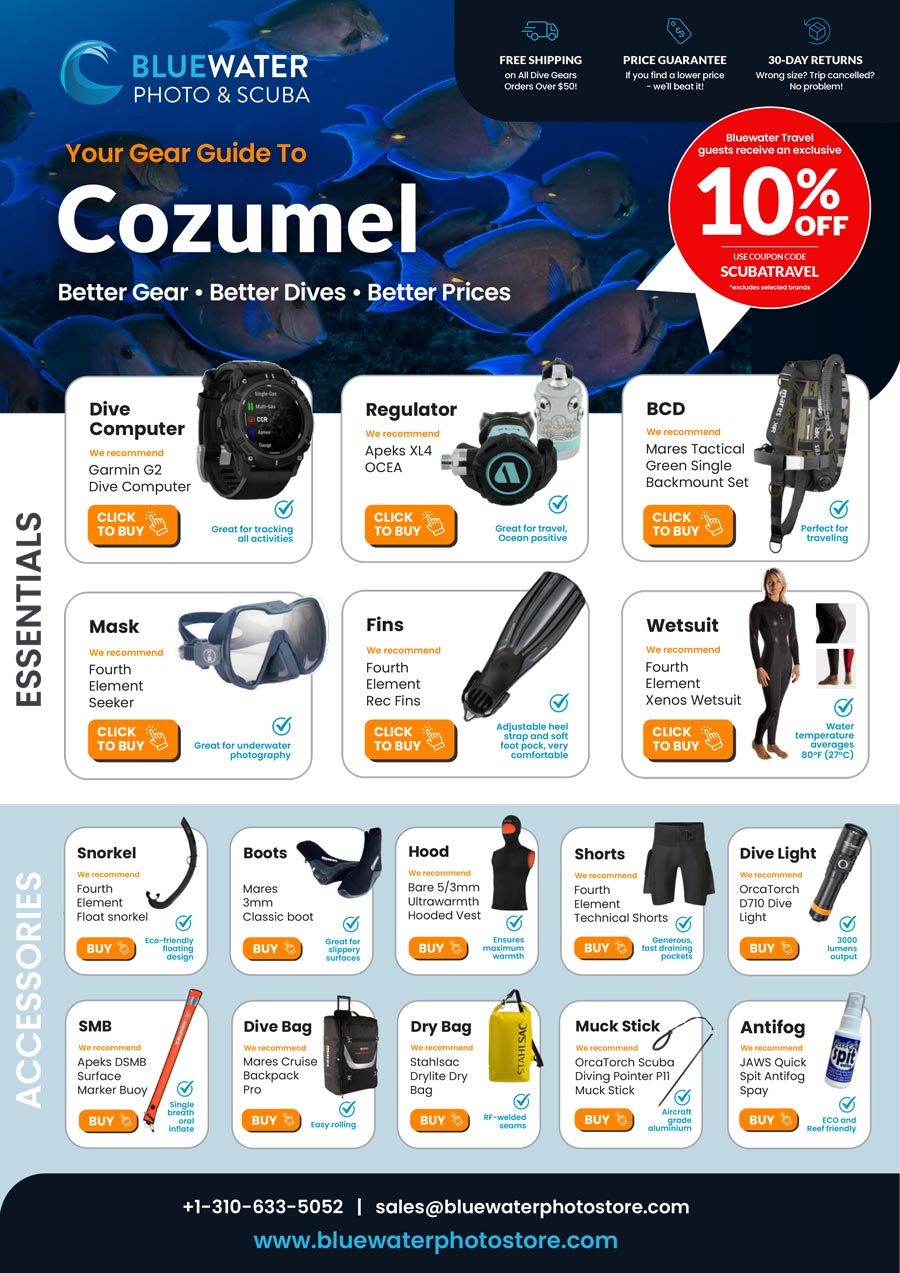
For information on the recent Scuba Club Cozumel closure announcement, please read our detailed article.
